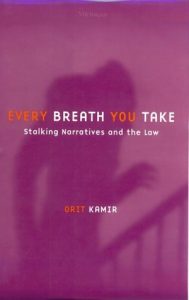Every Breath You Take: Stalking Narratives and the Law
 Every Breath You Take traces the evolution of notions of stalking and stalkers from ancient mythology through medieval folklore and nineteenth-century literature to contemporary film and social science. Critically analyzing stories of stalking within a wide range of historical and cultural discourses, the book suggests that such stories serve social functions, enforcing traditional gender roles within the patriarchal social order. It reveals how stories of stalking have facilitated moral panics that have fueled the persecution of “stalkers” as social deviants. It argues that a contemporary “stalking moral panic” led to America’s anti-stalking laws, laws that actually address mythological images and stereotypes and are therefore inadequate in their treatment of the actual social phenomenon of stalking. It concludes by suggesting an alternative legal treatment of stalking, one that relies on an informed, critical reading of both moral panics and culture.
Every Breath You Take traces the evolution of notions of stalking and stalkers from ancient mythology through medieval folklore and nineteenth-century literature to contemporary film and social science. Critically analyzing stories of stalking within a wide range of historical and cultural discourses, the book suggests that such stories serve social functions, enforcing traditional gender roles within the patriarchal social order. It reveals how stories of stalking have facilitated moral panics that have fueled the persecution of “stalkers” as social deviants. It argues that a contemporary “stalking moral panic” led to America’s anti-stalking laws, laws that actually address mythological images and stereotypes and are therefore inadequate in their treatment of the actual social phenomenon of stalking. It concludes by suggesting an alternative legal treatment of stalking, one that relies on an informed, critical reading of both moral panics and culture.
The study shows how Lilith—Jewish mythology’s Queen of Demons—as Western culture’s archetypal female stalker, eventually inspired the construction of the images of the medieval witch and nineteenth-century prostitute. Similarly, the vampire—our culture’s archetypal male stalker—can be seen in Frankenstein’s creature, in Mr. Hyde, and in Dracula, as well as in more contemporary images of male stalkers (such as Robert DeNiro’s taxi driver and Halloween’s Michael). Orit Kamir posits that in the twentieth century, film was the major force in developing images of male and female stalkers, leading to a moral panic that resulted in the 1980s anti-stalking laws. Careful reading of these laws reveals that they address cultural images of archetypal stalkers rather than the actual social phenomenon of stalking, which involves ordinary men and women, not mythological monsters.
The book is unusual in its combination of cultural studies with a sociological perspective and legal analysis. It argues that legal analysis can be greatly informed by close, critical textual reading of both relevant stories and social phenomena. It will be of keen interest to those in critical legal studies as well as scholars in film, literature, and folklore.